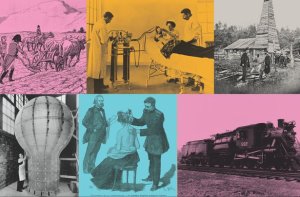Here is a brief excerpt from James Fallows‘ introduction in his article written for The Atlantic. To read the complete article, obtain subscription information, and sign up for free email alerts, please click here.
* * *
Why did it take so long to invent the wheelbarrow? Have we hit peak innovation? What our list reveals about imagination, optimism, and the nature of progress.
Some questions you ask because you want the right answer. Others are valuable because no answer is right; the payoff comes from the range of attempts. Seven years ago, The Atlantic surveyed a group of eminent historians to create a ranked list of the 100 people who had done the most to shape the character of modern America. The panelists agreed easily on the top few names — Lincoln, Washington, Jefferson, in that order — but then began diverging in intriguing ways that reflected not simply their own values but also the varied avenues toward influence in our country. Lewis and Clark, or Henry Ford? Thomas Edison, or Martin Luther King? The result was of course not scientific. But the exercise of asking, comparing, and choosing helped us understand more about what these historical figures had done and about the areas in which American society had proved most and least open to the changes wrought by talented, determined men and women.
Now we turn to technology. The Atlantic recently assembled a panel of 12 scientists, entrepreneurs, engineers, historians of technology, and others to assess the innovations that have done the most to shape the nature of modern life. The main rule for this exercise was that the innovations should have come after widespread use of the wheel began, perhaps 6,000 years ago. That ruled out fire, which our forebears began to employ several hundred thousand years earlier. We asked each panelist to make 25 selections and to rank them, despite the impossibility of fairly comparing, say, the atomic bomb and the plow. (As it happens, both of these made it to our final list: the discovery and application of nuclear fission, which led to both the atomic bomb and nuclear-power plants, was No. 21 of the top 50, ahead of the moldboard plow, which greatly expanded the range of land that farmers could till, at No. 30.) We also invited panelists to add explanations of their choices, and I followed up with several of them and with other experts in interviews.
One panelist ranked his choices not by importance but by date of invention, oldest (cement) to newest (GPS satellites). Some emphasized the importance not of specific breakthroughs but of broad categories of achievement. For instance, Joel Mokyr, an economic historian at Northwestern, nominated in his top 10 “modularity.” By that he meant the refinements in industrial processes that allowed high-volume output of functionally identical parts. This enabled mass production and the Henry Ford–style assembly line(49 on The Atlantic’s list), and the profound shift from handmade to volume-produced versions of everything. Modularity didn’t make it onto our final list; the adoption of standardized shipping containers, which extended the same logic in a different realm, just missed the cut.
In short, these scientists and creative types decided to answer the question they wanted us to ask, rather than the exact one we posed. We have new sympathy for people attempting to manage universities and R&D labs. But in the end we had enough comparable and overlapping suggestions, from enough people, with enough spelled-out explanations, and enough force of experience and insight behind them, to be comfortable presenting The Atlantic’s survey of humanity’s 50 most important technical breakthroughs since the wheel. We converted all the responses into values we could enter on a spreadsheet; we weighted, as reasonably as we could, the intensity and breadth of support; we watched the combined rankings go up and down as each new response arrived; and we came up with the final ranking you see here.
* * *
To read the complete article, please click here.
James Fallows is a national correspondent for The Atlantic and has written for the magazine since the late 1970s. He has reported extensively from outside the United States and once worked as President Carter’s chief speechwriter. His latest book is China Airborne. To learn more about him, please click here.
